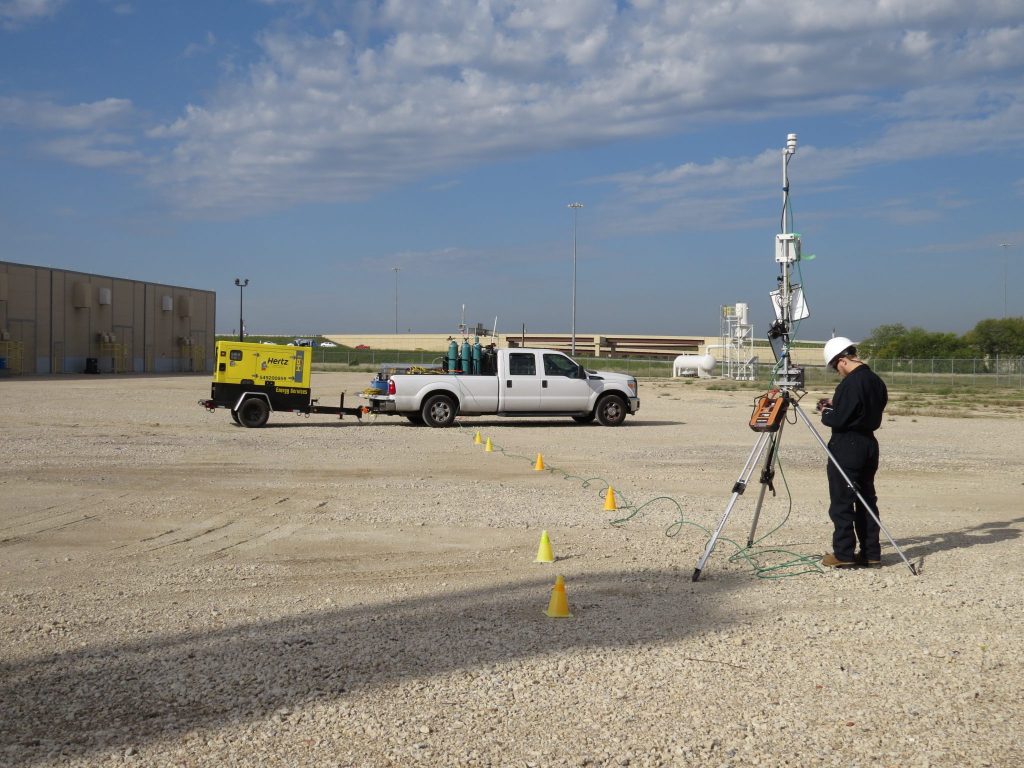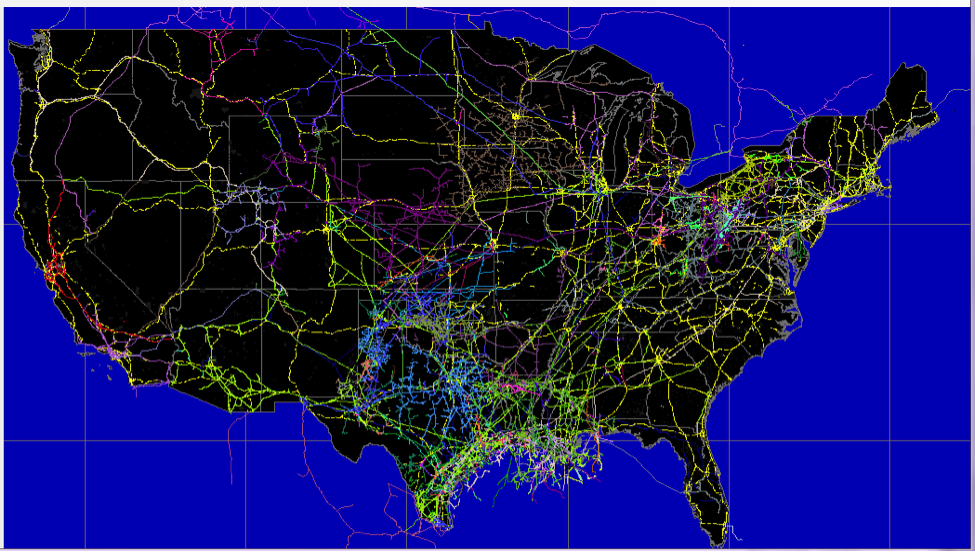Methane: Transmission and Storage
Measuring methane loss during the transportation stage of production
Methane is the primary component of natural gas and is a greenhouse gas many times more potent than carbon dioxide when released into the atmosphere unburned. The nation’s vast natural gas infrastructure – including wells, pipelines, and storage facilities – is one of many sources of methane emissions in the United States.
The goal of this study was to estimate methane emissions from the transmission and storage (T&S) sector of the U.S. natural gas industry. The U.S. transmission and storage sector contains approximately 1,800 compressor stations and underground storage facilities across 300,000 miles of pressurized natural gas pipelines.
The study focused on natural gas transmission compressor stations and underground storage stations. The study utilized a unique design which included multiple and simultaneous measurements, using different methods, at each facility. The field campaign measured emissions at nine storage facilities and 36 transmission facilities operated by study partners. Field data was augmented by additional measurements and public data sources to build a statistical model of national emissions for the T&S sector.
Study FAQs
What papers were considered when designing the study?
Three papers were foundational to the study and are referenced here:
GRI/EPA study — Harrison, M.R., T.M. Shires, J.K. Wessels, and R.M. Cowgill, (1996). “Methane emissions from the natural gas industry.” Volumes 1-15, Final Report. (Gas Research Institute and Environmental Protection Agency, Washington, D.C.) GRI-94/0257 and EPA-600/R-96-080.
ERG (2011). “City of Fort Worth: Natural Gas Air Quality Study (Final Report)”. Eastern Research Group, Inc., Morrisville, NC, USA. http://fortworthtexas.gov/gaswells/default.aspx?id=87074.
Harrison, M.R., Galloway, K.E., Hendler, A., Shires, T.M., Allen, D.T., Foss, M., Thomas, J., and Spinhirne, J. (2011). “Natural Gas Industry Methane Emission Factor Improvement Study: Draft Final Report.” Cooperative Agreement No. XA-83376101, US EPA.
Will the study team publish other papers on methane emission in the transmission and storage sector of the natural gas supply chain?
Yes, Papers that resulted from this study are as follows.
Methane Emissions from the Natural Gas Transmission and Storage System in the United States
Daniel J. Zimmerle, Laurie L. Williams, Timothy L. Vaughn, Casey Quinn, R. Subramanian, Gerald P. Duggan, Bryan Willson, Jean D. Opsomer, Anthony J. Marchese, David M. Martinez, and Allen L. Robinson (PDF)
Subramanian, Laurie L. Williams, Timothy L. Vaughn, Daniel Zimmerle, Joseph R. Roscioli, Scott C. Herndon, Tara I. Yacovitch, Cody Floerchinger, Daniel S. Tkacik, Austin L. Mitchell, Melissa R. Sullivan, Timothy R. Dallmann, and Allen L. Robinson (PDF)
Who sponsored the study?
The Colorado State University transmission and storage study was sponsored by the Environmental Defense Fund, Dominion, Dow Chemical, Enable Gas Transmission Company, the Interstate Natural Gas Association of America, Kinder Morgan, NiSource, TransCanada and Williams. It is one of 16 studies organized by EDF and industry partners to quantify methane emissions across the country’s entire natural gas supply chain. Environmental Defense Fund blog post
How many sites did the team visit?
The CSU-led research team, which also included researchers from Carnegie Mellon University, measured methane emissions at 45 sites in 16 states in the South, Midwest, Mountain West, Mid-Atlantic and Northeast regions of the country. Measurements were made at 36 pipeline compressor stations and at nine underground gas storage sites, which have both compressors and storage facilities. The team sampled more sites than were measured in three previous studies combined.
How were the sites selected?
Partner companies provided the research team with a complete list of their facilities and their internal schedule for greenhouse gas surveys. The research team chose facilities in order to include multiple geographic regions and a representative sample of facility types and operating conditions. Specific facilities were selected based upon logistical limitations, survey team availability, and accessibility of the facility for dual-tracer flux measurements. Selected facilities included both facilities required to report emissions to the Environmental Protection Agency Greenhouse Gas Reporting Program, and facilities that do not report.
Can you tell me the location of the sites that were selected and which company operates each one?
That information is not publicly available. The partner companies involved in the study provided the research team with access to sites on the condition that those locations were not made public.
How were measurements taken?
The research team used two independent, yet complementary, measurement techniques to quantify the methane emissions at each of the 45 sites. These techniques were onsite emissions measurements and downwind dual-tracer flux. Both methods were performed on the same day so researchers could directly compare the results from each method.
Why use two sampling methods?
By using these two methods, the research team was able produce two independent measurements of the facility-level methane emissions to improve confidence in the results.
When were the measurements taken?
Measurements were taken June-July 2013 and September-November 2013.
What is an onsite emissions measurement?
With this method, a comprehensive survey was performed to identify all methane emission sources at the target facility. Survey teams then measured the volumetric flow rate of natural gas released into the atmosphere from each emission source using instruments specifically designed for this purpose. These equipment-level measurements were then combined to estimate total emissions from the entire facility. This measurement method provides a “bottom-up” estimate of methane emissions at a T&S facility such as a compressor station.
What is downwind dual-tracer flux measurement?
Research personnel released specific “tracer gases” (acetylene and nitrous oxide) at a carefully controlled rate from each facility. A second group of research personnel measured concentrations of the tracer gases—methane, ethane, carbon dioxide and other gases—downwind of the site using high-time resolution instruments mounted in a mobile laboratory. Measurements of the tracer gases are correlated with the measurements of methane to estimate the amount of methane being emitted at the facility. Measurements of other natural gas components, such as ethane, allow the researchers to distinguish between methane emitted from the facility versus methane emissions originated from other nearby sources. This method is used to measure the magnitude of overall methane emission for a facility.
What about exhaust stack emissions for engine or turbine driven equipment?
Only methane emissions are being considered in the present study. Methane is emitted from the exhaust stack of an operating internal combustion device. Direct measurements of exhaust stack emissions were not made during onsite emission measurements. Instead, an emission factor based on AP-42 was used to estimate the methane emissions from the exhaust stacks of operating combustion devices at measured facilities.
How many samples were taken at each site?
The amount of data collected at a facility varied by the type and size of the facility, its accessibility, and other conditions. Sufficient data was collected at 45 facilities which were included in the study. One other facility was measured but was not included in the final analysis due to insufficient measurement quantity or quality.


